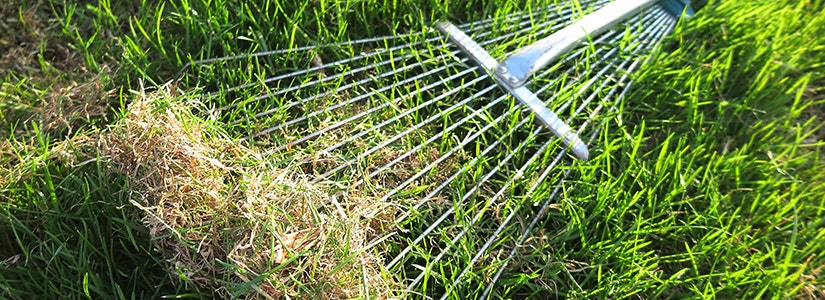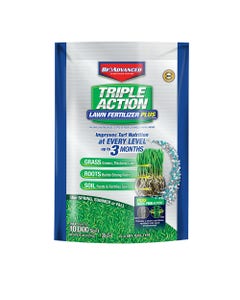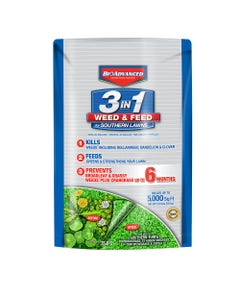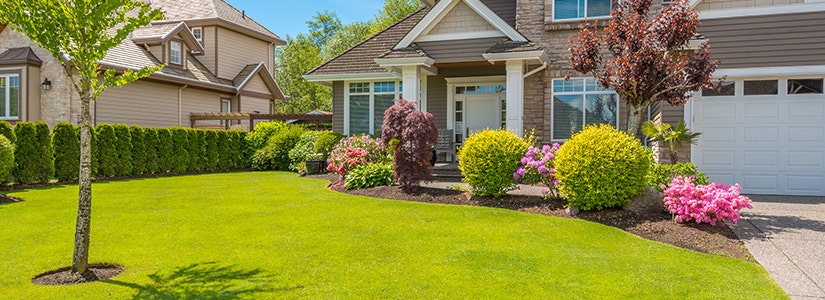

- Home
- Solution Center
- Learn
- Lawn and Landscape
- How To: Dethatch Lawns
How To: Dethatch Lawns
Thatch is a dense layer of dead and living organic material (grass stems, roots, etc) that forms between grass blades and the soil and roots. When it gets too thick, thatch can impede the penetration of water, air and nutrients, stressing the lawn. If your lawn feels spongy when you walk on it, it probably has a thick layer of thatch. You can check by removing a small section of sod with a shovel.
When a thatch layer is more than ½ inch thick, it's probably time to dethatch. You have three options: remove thatch manually, rent equipment or hire a professional lawn care service. Also realize that a dethatcher tears up a lot of material that is difficult to rake up and must be disposed of.
Manual Removal
For small lawns or thatch less than 1 inch thick, consider removing thatch with a rake. Doing the job manually causes the least amount of stress to a lawn. A rake with hard tines may or may not work effectively to pull thatch to the soil surface.
A specialized dethatching rake has sharpened tines designed to lift thatch away from soil. With this type of rake, use the same motion as with a traditional rake, allowing tines to dig into thatch and pulling it upward to loosen and lift thatch. Done correctly, you should feel the thatch separating from soil and see it being lifted to the lawn surface.
Rent Equipment
A dethatcher is also known as a vertical cutter, verticutter or power rake. This machine has vertical blades or rigid wire tines that slice into the organic layer and lift it to the lawn surface.
When using a dethatcher, blades must be set to a specific spacing based on grass type. Typically, the rental facility will do this, but be sure to ask. Cutting depth is also adjustable. Usually you want blades to cut no deeper than ½ inch into soil, if at all. The rental agency should be able to advise you.
A dethatcher is a large, heavy machine that requires some muscle to maneuver. You'll need a truck to transport it and more than one person to load and unload it. Consider sharing costs with neighbors and revitalize all the lawns nearby.
Hire A Professional
If you're uncertain about using a dethatcher, consider hiring a lawn service company to do this task. Trim costs by having them only perform a dethatch, while you tackle the follow-up tasks.
Practical Tips
- Mow grass to half its normal height first. This allows you to see the thatch layer more clearly and observe your progress as you go.
- Flag irrigation heads or other hidden objects in the lawn to avoid damaging them.
- For best results, always dethatch in at least two directions at 90° angles to one another.
When To Dethatch Your Lawn
The process is hard on turf, so the ideal time to tackle this chore is right before grass enters its period of strongest growth. This is usually also the best time to plant a lawn, so some people will level all or bad parts and reseed after renovating.
Because warm- and cool-season grasses grow most vigorously at different times during the year, the ideal time for this chore also varies. It's vital to know what kind of grass comprises your lawn before you dethatch.
Warm-Season Turf
In regions that experience frost and occasional snow, dethatch warm-season grasses in late spring to early summer – well before heat arrives and the lawn's water needs are high. In the warmest regions, including the Coastal South and Southern California, dethatch warm-season grass in early spring, but be sure to wait until grass is actively growing. This means you should have mowed it once or twice.
Warm-season turf types:
- Bahiagrass
- Bermudagrass
- Buffalo Grass (doesn't usually develop thatch)
- Centipedegrass
- St. Augustinegrass
- Zoysiagrass
Cool-Season Turf
Dethatch cool-season turf types in early spring or early fall. Timing is critical in both cases. In early spring, dethatch after grass is actively growing – after you have mowed it once or twice. Time early in the Fall to allow grass plenty of time to grow and re-establish before frost or cold weather arrives.
Cool-season turf types:
- Creeping Bentgrass
- Fescue (Chewings, Hard, Red; Tall Fescue rarely needs dethatching)
- Kentucky Bluegrass
- Rough Bluegrass
- Ryegrass (perennial that rarely needs dethatching)
Timing Tips
- Dethatch when soil is moist, not dry. If soil is too wet, a dethatch may yank turf out by the roots, creating large bare spots.
- It's best to dethatch during cooler weather.
- Mow the lawn to half its normal height right before dethatching.
- Postpone dethatching – even if it's needed – during times of drought, watering restrictions or intense heat waves.
- Avoid heavy dethatching in mid- to late fall for any kind of lawn. Late-season dethatching sends grass into winter weak and damaged, which can affect survival.
What To Do Afterwards
Expect your lawn to look somewhat ragged after. Follow these steps to groom a healthy lawn – a process that should take 3-4 weeks.
- Rake and remove the thatch scattered over grass. This can be a lot of work and generate a good deal of organic material. If you are performing a dethatch on a non-aggressive grass or a lawn with few weeds, you can compost or use it as mulch – but only if you haven't applied a weed-and-feed product recently (check label for appropriate waiting period).
- With more aggressive, seedy grass types, such as common Bermudagrass, or with weedier lawns, it’s best to dispose of the organic material according to local regulations.
- If dethatching created bare spots, reseed. After applying seed, rake it into soil. Add a light covering of organic matter, soil or sand.
- Fertilize afterwards. If dethatching occurs around the time of your lawn's regular seasonal fertilizing, delay fertilizing until after you have dethatched.
- Keep recently dethatched lawns well-watered to ensure grass recovers. Watering is especially important if you reseed.
Prevent Future Thatch
Proper watering, fertilizing, mowing and regular aeration help prevent thatch build-up. Follow proper techniques in these areas, and you'll only have to dethatch as needed, not as a regular lawn chore.
Alternatives To Dethatching
If your lawn has mild thatch, a plug aerator may be effective. The aerator dethatches the lawn in each spot where plugs are removed, while avoiding the creation of bare spots that a dethatcher causes. Regular aerating can help prevent thatch build-up. Learn more about How To Aerate Your Lawn. If you have a very weedy or unhealthy-looking lawn, you may want to renovate, which involves killing the entire lawn and reseeding.















